Fairy Tail is an anime/manga series that gained popularity thanks to its light humor, heartfelt moments, magical world, and above all, loveable characters. It’s not breaking into many Top 10 lists, but it’s entertaining enough for what it tries to be — a typical shonen-genre story that’s just fun to read or watch.
The Fairy Tail RPG, on the other hand, doesn’t have the same magic as the show or the manga. It was delayed once before launch, yet it still feels as though it needed a bit more time to reach its full potential.
The right ideas are certainly there as a foundation, but the game is much better in concept than it is in execution. A few familiar faces and places aren’t enough to keep this game’s spells from missing the mark.
Fairy Tail Review: Not Enough Magic
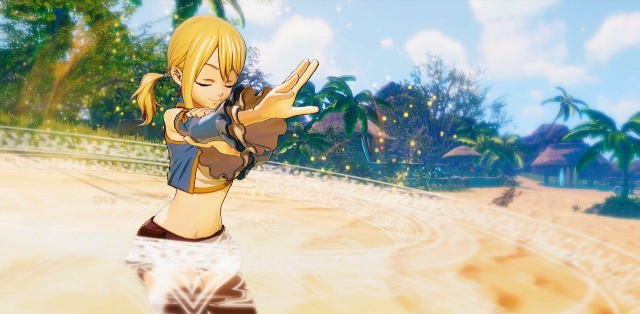
As advertised, this Fairy Tail outing drops players right in the middle of the plot. To be more specific, the game starts at the end of the Tenrou Island arc. That means it begins around episode 122 of the anime and chapter 253 of the manga.
The opening scene has players use the primary mages from the Fairy Tail guild as they confront the leader of Grimoire Heart, Hades. You take control of Natsu, Lucy, Erza, Gray, and Wendy for this little tutorial fight.
If that sounded even the slightest bit confusing, then prepare to be extremely overwhelmed by everything if you’re not at least that far into the series before starting this game. You’ll also need to get used to hearing the Japanese voices while reading subtitles if you’re used to hearing the English dub. It’s the only option here.
There’s an in-game encyclopedia for terms, characters, and missed plot points, but it’s a lot to take in as you start a new journey. For example, it begins with eight arcs you should read about, as well as 21 character bios and 19 important terms.
All of the encyclopedia entries are supposed to be helpful. But in actuality, you may just end up even more lost after reading them if you’re a newcomer. Some entries use terms you’ll have to learn about in other entries, creating a cycle of confusion.
New names and concepts are continuously used as the game’s plot darts from one major conflict to the next with little bits of narration from Lucy to bridge the unseen gaps in between. It can be hard to keep up with, and I say this as someone who finished the Fairy Tail manga back when it ended in 2017.
I can only imagine the struggle of newer fans or curious first-timers.
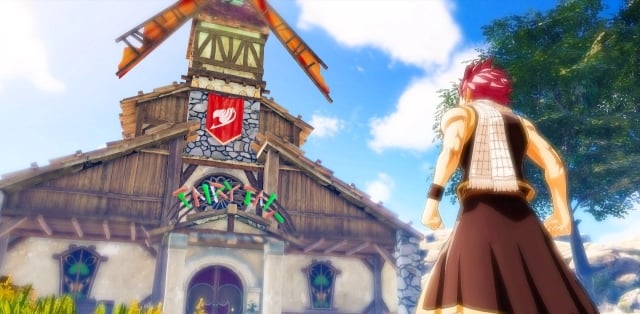
Fairy Tail truly begins shortly after that Hades battle, with the start of the X791 arc. A significant time skip occurs, and the Fairy Tail guild isn’t the household name it used to be. You’ll be charged with upgrading various aspects of the guild while completing quests to regain Fairy Tail’s popularity and rank among the other guilds in the world.
This is one of those ideas that seems better in concept. The gameplay system in Fairy Tail has you constantly ranking up in a guild leaderboard. In doing so, you’re supposed to feel as though the guild is getting more recognition, but it never feels that way because the world is empty and soulless, which might be one of the worst offenses for a Fairy Tail game.
There are maybe a total of eight different NPC models for the townsfolk in the game, and not everyone in the Fairy Tail guild has a character model. Some will just start talking out of nowhere, despite not being on screen. Because of this, the guild is full of random NPCs that look alike to make the building feel more full. It’s a bit sad to look at.
To surround yourself with these adoring townspeople, you’ll need to take on a number of uninspired, not-so-optional side quests in bland, maze-like locations. This might be a consequence of playing on the Switch, but those bland areas are also on the ugly side, graphically.
There’s definitely some side content that fans of the series will enjoy for the charming character interactions alone. Seeing Erza trying to act on stage again is one of those perfect moments, but the majority of them feel like unnecessary padding.
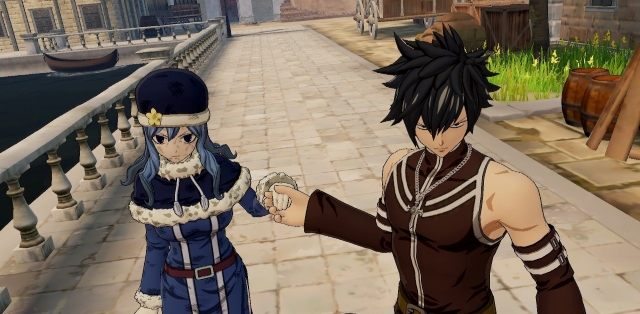
These side quests also feel mandatory from a gameplay perspective because certain main story missions are locked behind a specified guild rank. They’re also needed to grind for levels, upgrading characters, and building bonds between companions, which allows you to chain their moves together.
Grinding isn’t the issue here, though. The main problem with Fairy Tail’s side quests is that they all feel more or less the same. You go to a location, defeat some monsters or bandits, then return for your reward. That’s it.
What makes matters worse is that you can only accept one task from the guild’s quest board at a time. It’s a tedious gameplay loop that boils down to finishing a simple kill quest just to return, then set out on another similar quest.
The amazing fast travel system ends up saving these quest loops from being unbearable. You can fast travel anywhere on the world map at any point in time. There are even multiple fast travel points within small locales, so you never really have to even physically run anywhere for very long. The game also provides the options to skip battle animations, and/or use an auto-battle feature.
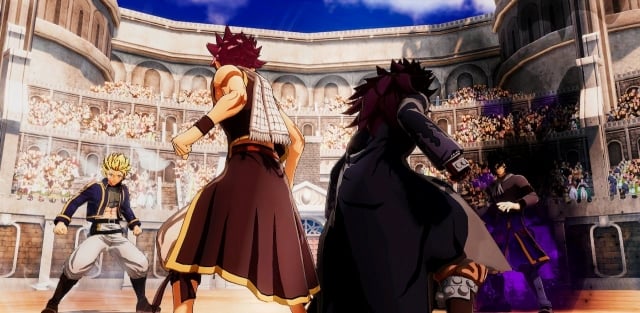
The battle system in Fairy Tail isn’t exactly one that fans were expecting. At first glance, the series’ over-the-top action seems more suited for a 3D arena fighter like so many other anime-based games.
However, I’m happy to say that Fairy Tail works well enough with turn-based RPG combat. There are currently 16 playable characters, each with unique move types, strengths, and weaknesses. In most battles, you can use up to five mages at once to take down enemies on a grid-style board. Your mages can be swapped out and changed in the guild unless your team is set automatically for plot reasons.
Creating my own dream team full of powerhouses, healers, support characters, and tanks was a ton of fun. The game rewards players for both experimentation and stability. Using every character or sticking with the same team for long periods of time both have benefits.
Experimenting leads to everyone being strong enough during mandatory plot-related switches, and sticking with the same team allows bonds to grow between characters, unlocking new chain attack bonuses.
I found myself trying out multiple different characters because, honestly, the majority of spells look good, even though too many effects on screen at once can make the framerate dip. It’s still a pleasure to see iconic moves from the series used as attacks in-game. Though, ultimately, you’ll most likely end up turning those animations off to get through missions quicker.
Fairy Tail Review — The Bottom Line
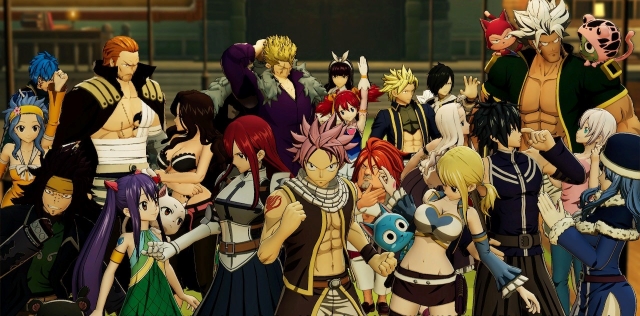
Pros
- Characters are still lovable and faithful to the source material
- Rewarding, customizable party system
- Combat is solid and entertaining
Cons
- Story skips significant moments, making it harder to follow
- Extremely repetitive mission structure
- World feels bland and empty
Fairy Tail has many shortcomings as the series’ first console outing. It’s a chore to get through after a while, thanks to all of the near-identical quests that blend together by the end.
Thankfully, the combat is enjoyable, and the characters are done right. Happy and Natsu still show up at Lucy’s house uninvited, and Juvia still loves Gray so much that she owns a cardboard cut out of him.
It’s those little moments that’ll make Fairy Tail fans smile, despite the game’s faults. And for that reason, I can only recommend this one to those who already enjoy the series.
[Note: A copy of Fairy Tail was provided by Koei Tecmo for the purpose of this review.]

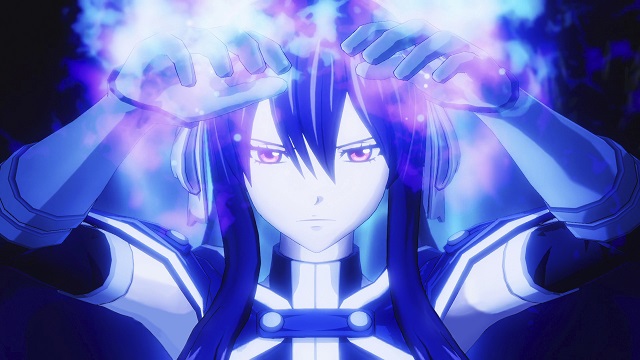





Published: Jul 30, 2020 06:44 pm